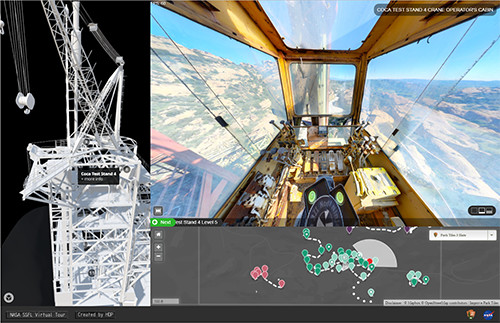 View from inside of Coca test stand crane cabin as seen in the National Park Service
SSFL Virtual Tour
View from inside of Coca test stand crane cabin as seen in the National Park Service
SSFL Virtual Tour
In cooperation with NASA, the National Park Service’s (NPS) Heritage Documentation Program produced an interactive, virtual tour of NASA’s Test Stand Areas at Santa Susana Field Laboratory (SSFL) .
The virtual tour includes 360-degree panoramas of the three test areas and the surrounding landscape as well as the interiors of the test stands. The documentation focuses on six rocket test stands in the Alfa, Bravo, and Coca Test Areas. Each of the test stands are eligible for nomination to the National Register of Historic Places given their significance in the contexts of the Cold War and Space Exploration, and for their achievements in engineering and design.
Along with the virtual tour, the Santa Susana Field Laboratory Documentation Project includes photography, 3D modeling, laser scans, animation and drawings.
The Historical Operations section of this website provides further information about the history of the test stands.
The Historic Documentation Program (HDP) administers the Historic American Buildings Survey (HABS), the Federal Government's oldest preservation program, and its companion programs: the Historic American Engineering Record (HAER) and the Historic American Landscapes Survey (HALS). Documentation produced through HABS/HAER/HALS constitutes the nation's largest archive of historic architectural, engineering, and landscape documentation. Records of this and more than 40,000 other historic sites are maintained in a special collection at the Library of Congress. HDP also develops and maintains the Secretary of the Interior's Standards and Guidelines for Architectural and Engineering Documentation .
Documentation provides a permanent record of the nation's most important historic sites and large-scale objects. The Collection is unique in the strong support it enjoys from its institutional sponsors and the public, and is distinguished in its national scope, consistent format, archival stability, and continued growth. The documentation contributes to wider recognition and appreciation of historic resources as National Historic Landmarks, provides baseline documentation for rehabilitation and restoration, and makes available well-researched materials for interpretation and illustration. Unsurprisingly, it is the most heavily used collection at the Library of Congress' Division of Prints and Photographs.
For more information, visit the Historic Documentation Program website.